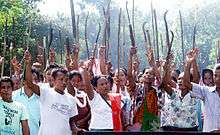Bandh

Bandh is a form of protest used by political activists in South Asian countries such as India and Nepal. It is similar to a general strike. During a bandh, a political party or a community declare a general strike.[1] For eg. A Bharat bandh is a call for a bandh across India, and a bandh can also be called for an individual state or municipality.
The community or political party declaring a bandh expects the general public to stay at home and not report for work. Shopkeepers are expected to keep their shops closed, and public transport operators of buses and cabs are expected to stay off the road and not carry passengers. There have been instances when large metropolitan cities have been brought to a standstill.[2]
A bandh is a powerful means of civil disobedience, and because of its huge impact on the local community, it is a much-feared tool of protest.[3]
Burglary, forced closures, arson attacks, stoning, and clashes between the bandh organizers and the police are common during the period of closure.
Ban
The Supreme Court of India ruled against any sort of hooliganism in the name of 'bandh' in 1998,[4] but political parties still organize them. In 2004, the Supreme Court of India fined two political parties, Bharatiya Janata Party (BJP) and Shiv Sena, for organizing a bandh in Mumbai as a protest against bomb blasts in the city.[4] The government of West Bengal also banned bandh often conducted by the communist party of India. [5]
Notable bandhs
Bandh was a common phenomenon by congress party in many states where they are in opposition.[6] The National Democratic Alliance (NDA) and 13 non-UPA parties called for a nationwide bandh on 5 July 2010, to protest a fuel price hike. This bandh prevented Indians from carrying out day-to-day tasks, especially in states that were ruled by the NDA and the left.[7] In Nepal, calls for bandhs have increased due to political instability.
Bharat bandh was called by the opposition party NDA on 31 May 2012, to protest against a steep hike in petrol prices.[8]
On 20 September 2012, the BJP and otherparties called for a nationwide bandh in response to economic reforms undertaken by Prime Minister Manmohan Singh and his finance minister Palaniappan Chidambaram. Chief among their grievances were the cut in subsidies for diesel and cooking gas and the decision to allow foreign investors to own majority stakes in the retail sector, including supermarkets and department stores.[9]
One noteworthy incident is of bandh after the Akshardham Temple attack in Gujarat, in September 2002; it was the first time in history that a nationwide bandh was called after a tragic incident. All of India remained closed, from small tea stalls to the commodity and other stock markets at the Bombay Stock Exchange.
In 2016, the states of Kashmir, Gujarat, and Karnataka were most badly affected by frequent bandhs and strikes.
See also
References
- ↑ "Will Bharat Bandh shut Mumbai down on Thursday?". NDTV. 28 May 2012. Retrieved 30 May 2012.
- ↑ "Bengaluru to shut on Bharat Bandh". Deccan Chronicle. Retrieved 30 May 2012.
- ↑ "Bharat Bandh on May 31 against UPA's petrol bomb". Yahoo News. Retrieved 30 May 2012.
- 1 2 Pay damages first, court tells parties; The Hindu, Saturday, 17 September 2005
- ↑ Note ban: Mamata refuses to support opposition bandh on 28 November. Catch News. Retrieved on 19 June 2017.
- ↑ Congress advances 12-hour Bengal bandh call to August 18. The Indian Express (11 August 2015). Retrieved on 2017-06-19.
- ↑ Bharat bandh affects normal life across the country. Indian Express (5 July 2010). Retrieved on 2017-06-19.
- ↑ "Bandh hits normal life in Karnataka". The Times Of India. 31 May 2012.
- ↑ Mallet, Victor (20 September 2012). "Indians Voice Anger at Reform Plans". Financial Times. Retrieved 24 September 2012.
Further reading
- Johari, J. C. (1982). Comparative Politics. Sterling Publishers Pvt. Ltd, New Delhi. ISBN 8120704681. Chapter 20: Techniques of Pressure Politics. pp. 393–410.